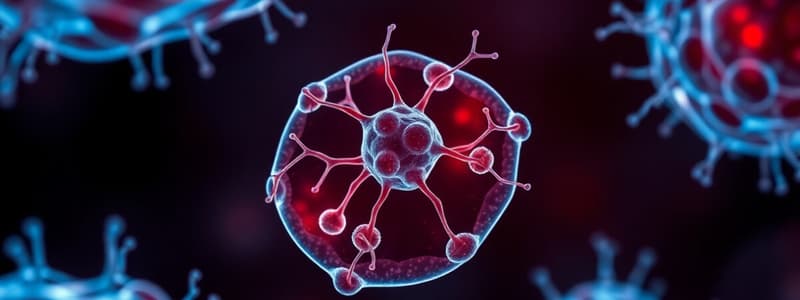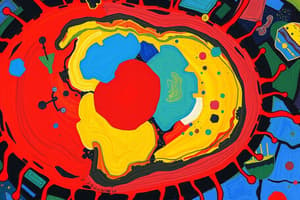Podcast
Questions and Answers
What is the primary function of mitochondria in cells?
What is the primary function of mitochondria in cells?
- Production of waste products
- Production of ATP (correct)
- Synthesis of proteins
- Storage of genetic material
What structural feature of the inner membrane of mitochondria increases ATP production?
What structural feature of the inner membrane of mitochondria increases ATP production?
- It contains pigments for energy absorption.
- It is thick and rigid.
- It is thrown into folds called cristae. (correct)
- It is completely impermeable.
How do cells benefit from the breakdown of ATP molecules?
How do cells benefit from the breakdown of ATP molecules?
- It releases energy for cellular processes. (correct)
- It stores nutrients for future use.
- It transmits signals to other cells.
- It produces carbon dioxide.
Which part of the mitochondria contains the necessary enzymes for ATP production?
Which part of the mitochondria contains the necessary enzymes for ATP production?
What type of genetic material do mitochondria possess?
What type of genetic material do mitochondria possess?
What distinguishes the outer membrane of mitochondria from the inner membrane?
What distinguishes the outer membrane of mitochondria from the inner membrane?
Why is a larger surface area in mitochondria beneficial for ATP production?
Why is a larger surface area in mitochondria beneficial for ATP production?
What is the primary function of ATP produced in eukaryotic cells?
What is the primary function of ATP produced in eukaryotic cells?
Which of the following statements about the outer membrane of the mitochondrion is true?
Which of the following statements about the outer membrane of the mitochondrion is true?
What percentage of the outer membrane is composed of lipids?
What percentage of the outer membrane is composed of lipids?
Which of the following substances can pass through the outer membrane of the mitochondrion?
Which of the following substances can pass through the outer membrane of the mitochondrion?
What type of phosphorylation occurs when ATP is produced in eukaryotic cells?
What type of phosphorylation occurs when ATP is produced in eukaryotic cells?
Which component is NOT synthesized using ATP in eukaryotic cells?
Which component is NOT synthesized using ATP in eukaryotic cells?
What is the role of porins in the outer membrane?
What is the role of porins in the outer membrane?
What type of molecules can the outer membrane's porins typically transmit?
What type of molecules can the outer membrane's porins typically transmit?
What feature of the inner membrane significantly increases its surface area?
What feature of the inner membrane significantly increases its surface area?
What characteristic makes the lipid bilayer of the inner membrane highly impermeable?
What characteristic makes the lipid bilayer of the inner membrane highly impermeable?
What is the function of the integral proteins in the inner membrane?
What is the function of the integral proteins in the inner membrane?
What distinguishes the cristae of steroid-secreting cells from those in most mitochondria?
What distinguishes the cristae of steroid-secreting cells from those in most mitochondria?
What two membrane-limited spaces are created by the mitochondrial membranes?
What two membrane-limited spaces are created by the mitochondrial membranes?
What component of the inner membrane plays a significant role in mitochondrial ATP synthase activity?
What component of the inner membrane plays a significant role in mitochondrial ATP synthase activity?
Where is the intermembrane space located within the mitochondrion?
Where is the intermembrane space located within the mitochondrion?
Which of the following elements is not part of the electron transport system located in the inner membrane?
Which of the following elements is not part of the electron transport system located in the inner membrane?
What is the structure of the space located between the inner and outer membranes called?
What is the structure of the space located between the inner and outer membranes called?
Which type of ribosomes are associated with the inner surface of the inner membrane?
Which type of ribosomes are associated with the inner surface of the inner membrane?
What is the primary function of sap vacuoles in plant cells?
What is the primary function of sap vacuoles in plant cells?
Which component primarily makes up the content of vacuoles?
Which component primarily makes up the content of vacuoles?
What surrounds the vacuole in a cell?
What surrounds the vacuole in a cell?
What is contained within the mitochondrial matrix?
What is contained within the mitochondrial matrix?
Which of the following is NOT a symptom of mitochondrial diseases?
Which of the following is NOT a symptom of mitochondrial diseases?
Which type of vacuole is primarily found in fat cells?
Which type of vacuole is primarily found in fat cells?
What role do matrix granules have in the mitochondria?
What role do matrix granules have in the mitochondria?
From where do vacuoles typically originate?
From where do vacuoles typically originate?
Which of the following processes is NOT associated with the enzymes in the mitochondrial matrix?
Which of the following processes is NOT associated with the enzymes in the mitochondrial matrix?
What type of vacuole is responsible for controlling the water content of certain single-celled organisms?
What type of vacuole is responsible for controlling the water content of certain single-celled organisms?
What is the primary function of mitochondria in cells?
What is the primary function of mitochondria in cells?
Which pigment can be found in sap vacuoles that contributes to a plant's color?
Which pigment can be found in sap vacuoles that contributes to a plant's color?
What is tonoplasm?
What is tonoplasm?
What could potentially cause mitochondrial diseases?
What could potentially cause mitochondrial diseases?
Which of the following is NOT a type of vacuole mentioned?
Which of the following is NOT a type of vacuole mentioned?
Which membranes are present in a mitochondrion?
Which membranes are present in a mitochondrion?
Which of the following statements correctly describes cristae?
Which of the following statements correctly describes cristae?
In which type of cells are sap vacuoles most abundant?
In which type of cells are sap vacuoles most abundant?
Which of the following factors does NOT influence mitochondrial function?
Which of the following factors does NOT influence mitochondrial function?
How can disturbances in mitochondrial function manifest in the body?
How can disturbances in mitochondrial function manifest in the body?
Flashcards are hidden until you start studying
Study Notes
Mitochondria Overview
- Mitochondria are double-membrane organelles known as the "powerhouse of the cell."
- They produce ATP (adenosine triphosphate), the usable form of energy for cells.
- Enzymes convert energy from carbohydrates and fatty acids into ATP through oxidative phosphorylation.
Structure of Mitochondria
- Composed of an outer and inner membrane.
- The outer membrane is smooth and porous, allowing small molecules to pass.
- The inner membrane is highly folded into cristae, increasing surface area for ATP production.
- Contains a matrix rich in enzymes necessary for ATP synthesis and has its own DNA and ribosomes, enabling protein synthesis.
Function of Mitochondria
- ATP produced is vital for cellular functions such as movement, reproduction, and synthesis of compounds.
- Plays a crucial role in the oxidation of organic molecules to generate energy.
Outer Membrane Characteristics
- Composed of 50% lipids and 50% proteins.
- Contains transmembrane proteins called porins that form channels for small molecules.
- Allows the passage of molecules with molecular weights up to 10,000 Da.
Inner Membrane Characteristics
- Contains long folds (cristae) to enhance surface area.
- Lipid composition varies and includes unusual phospholipids.
- Highly impermeable to ions and selectively permeable to required small molecules.
- Houses components of the electron transport chain and ATP synthase activity.
Membrane-Limited Spaces
- Creates intermembrane space between the inner and outer membranes.
- The matrix space is enclosed by the inner membrane and contains the mitochondrial matrix.
Mitochondrial Matrix
- Composed of water, solutes, and matrix granules for calcium ion concentration regulation.
- Contains circular DNA and ribosomes.
- Enzymes in the matrix are involved in critical processes including the citric acid cycle and lipid oxidation.
Mitochondrial Diseases
- Include over 40 conditions linked to mitochondrial dysfunction, due to mutations in nuclear or mitochondrial DNA.
- Symptoms vary based on affected tissues, including muscle weakness, digestive problems, and developmental delays.
Vacuoles Overview
- Non-cytoplasmic areas in cells, separated by a membrane known as tonoplast.
- Store water, minerals, and other substances; vital for structure and osmotic pressure.
Types of Vacuoles
- Sap Vacuoles: Abundant in plant cells for storing sap, maintaining turgidity, and osmotic pressure.
- Contractile Vacuoles: Expandable and collapsible; help segregate substances and maintain osmotic balance.
- Food Vacuoles: Store nutrients and participate in digestion via phagocytosis.
- Air Vacuoles: Found in prokaryotes; store gases for buoyancy and structural strength.
Functions of Chloroplasts
- Key roles in photosynthesis and synthesis of nucleic acids, proteins, fatty acids, and vitamins.
Peroxisomes
- Single-membrane spherical organelles involved in hydrogen peroxide metabolism.
- Contain oxidases that produce hydrogen peroxide and catalases that break it down.
- Enzymes in peroxisomes assist in various metabolic reactions, including lipid degradation.
Studying That Suits You
Use AI to generate personalized quizzes and flashcards to suit your learning preferences.




